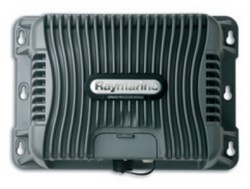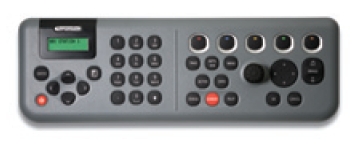Ray G, hints part 2
 Thanks to Richard’s sleuthy comments to the earlier G Series entry, here are some low res images of various G Series system components beyond the monitors. They’re snitched from an online price list (PDF) put up by French Raymarine distributer SD Marine. The text is in French, and not detailed, but I gather that the “Processeur” GPM400 above has a hard disk pre-loaded with Navionics Platinum charts for one large region—you choose U.S., Europe, or ROW (rest of world)—and Gold charts for the others. It also has dual DVI monitor outputs (1280×1024 pixel), two NMEA 0183 i/o ports, a SeaTalkNG/N2K port, and a 100mb SeaTalkHS/Ethernet port.
Thanks to Richard’s sleuthy comments to the earlier G Series entry, here are some low res images of various G Series system components beyond the monitors. They’re snitched from an online price list (PDF) put up by French Raymarine distributer SD Marine. The text is in French, and not detailed, but I gather that the “Processeur” GPM400 above has a hard disk pre-loaded with Navionics Platinum charts for one large region—you choose U.S., Europe, or ROW (rest of world)—and Gold charts for the others. It also has dual DVI monitor outputs (1280×1024 pixel), two NMEA 0183 i/o ports, a SeaTalkNG/N2K port, and a 100mb SeaTalkHS/Ethernet port.

There’s also a new keyboard which can apparently plug into an NG network directly, or wirelessly via an add-on transmitter and NG base station. One job of the little LCD is to tell you which screen you’re controlling. Finally there seem to be two new “HD Digital” open array radar product lines. Each has a 4kw base and a choice of 48” or 72” antennas, but one will work on both E- and G-Series processors, while the “Super HD” edition only works on G, has even greater target definition, and a higher list price. I also found this recent description of the whole G Series concept, which includes entertainment, plus a bit more about HD Radar. I’m really looking forward to seeing this gear on the water before the Fort Lauderdale show, and am told that much of it will already be shipping by then.













Thanks for the mention 🙂
Another link for you
http://translate.google.com/translate?sourceid=navclient&hl=en&u=www.masmar.com/articulos/art/126,4565,1.html
The G series processor is mentioned as being 10x faster than the prior Series, with a 40GB hard drive. Personally would expect a solid state flash drive..
Also mentioned is a DSM400 sounder module coming out for the G series. The maximum configuration of 8 network of displays, 4 GPM400, 8 keyboards, 1 DSM400, 2 radars and 2 GVM400 is stated.
I have read elsewhere about a possible software Upgrade to the E-series to work with the new HD digital arrays?
Thanks Ben !
Especially enjoyed reading about the benefits of hd radar.
Look at this: “Maritime radar standards chart new course as Internet technology goes to sea”
The article has many interesting elements, I am curious if the new Raymarine HD radar’s are based on WiMax technology. E.g. using the doppler information to detect if a target is noise, stationary, or moving.
http://www.iec.ch/online_news/etech/arch_2007/etech_0707/focus.htm
X-band radars operate circa 10GHz. high-power WiMax currently tops-out at circa 3.5GHz, although low-power unlicensed use on the 5.8GHz band is possible. hence, looking to WiMax for high-power semiconductors could maybe get you a modest S-band radar using pulse-compression techniques, but not an X-band radar, at least not right now.
there is work to get GaN (Gallium Nitride) power transistors cost-effective at X-band. (see http://www.nitronex.com/solutions/index.html for typical products) but for the moment, it’s very hard to beat the efficiency and simplicity of a Magnetron. they are *way* down the cost curves.
As for other semiconductor technologies, LDMOS is struggling at 1.9HGz and high-voltage GaAs appears to be still-born. (even Freescale, it’s most vocal exponent, appears to be backing away from it.) And there are working radios at 60GHz done with bulk CMOS process devices for “cordless” HD video, but that’s just across the room.
so unless you have the avionics budget of an F-22 or F-35, i wouldn’t hold my breath on a completely solid-state radar any time soon. yes, DSP in the receive path can improve matters a great deal, but on the transmit side, magnetrons will rule for quite some time to come.
there is interesting work, though, on clever techniques for driving a magnetron to exhibit adequate coherence for use in Doppler systems. see http://www.highbeam.com/doc/1G1-15406309.html for an example. this could take advantage of DSPs on both sides, possibly to considerable effect.
Raymarine has for download now a English brochure, with details of the G Series. And more information on the HD radar, both models it is stated will work with the E-series (The e-series software update??)
http://www.raymarine.com/SubmittedFiles/2007-UK-Cat/UK_English_07a_Pages%20Int%20Dealers.pdf
Another good catch, Richard; thanks! It looks to me like the “Super HD” radar shown in the French price list is not in this booklet.
Hi Ben,
You are right it does not have the Super HD. From the French price list, it looks like the base might be the thing which is different, as the antenna price for HD and Super HD is the same though the antennas do have differing part numbers. Perhaps a more advanced processor in the base, with better signal processing and able to provide closeup and long range images at the same time for the G series??
The DSM400 is interesting with 5 sensor inputs, 2 depth, 2 depth id and a speed temp. would be interesting to know the reason to drill 5 holes in a boat hull though, also weighs 12x more at 12kg (due to metal case).